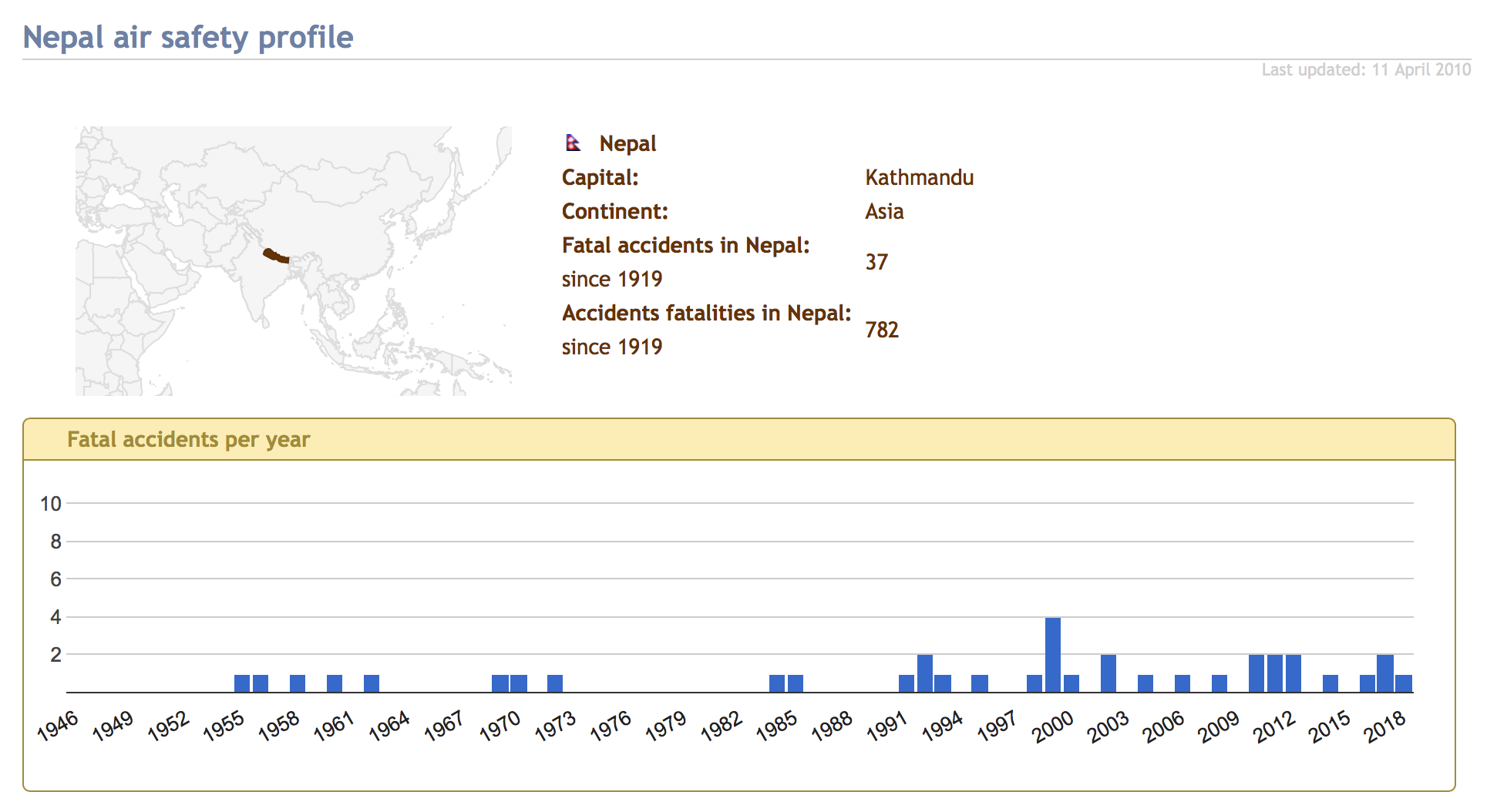We have recently heard about the US Bangla plane crash that took place on March 12 that took lives of 52 people out of 66 on board.
Till date the major airline mishaps in Nepal are:
- Thai Airways International Flight 311 – 31 July 1992
- Pakistan International Airlines Flight 268 – 28 September 1992
- Necon Air Flight 128 – 5 September 1999
- Indian Airlines Flight 814 – 26 December 1999
- Royal Nepal Airlines – 27 July 2000
- 2006 Yeti Airlines Twin-Otter crash – 21 June 2006
- 2006 Shree Air crash – 24 September 2006
- UN Helicopter crash – 3 March 2008
- Yeti Airlines Flight 103 – 8 October 2008
- Agni Air Flight 101 – 24 August 2010
- 2010 Okhaldhunga Twin Otter crash – 15 December 2010
- Buddha Air Flight 103 – 25 September 2011
- 2012 Agni Air Dornier 228 crash – 14 May 2012
- Sita Air Flight 601 – 28 September 2012
- Nepal Airlines Flight 555 – 16 May 2013
- Nepal Airlines Flight 183 – 16 February 2014
- Tara Air Flight 193 – 24 February 2016
- Air Kasthamandap PAC 750XL – 26 February 2016
- Summit Air Flight 409 – 27 May 2017
- US-Bangla Airlines Flight 211 – March 12 2018
As stated by The Himalayan Times, the database records (as per February 24, 2016) held total 53 air crashes in Nepal since May 7, 1946. The most fatal accident reported so far is the Pakistan Internal Airlines (PIA) flight 268 that occurred on 28th September 1992, killing all 167 people on board.
SEE ALSO: Nepal and Cyber Security: A REVIEW
What could possibly be the reason behind so many crashes you may ask? As per this Telegraph article, “poor training and weak regulations has added to the danger faced by air passengers in a country whose mountainous environment would be challenging to the most skilled of pilots.” The gist is that aircrafts here fly at a lower altitude as compared to other places, the weather pattern is unpredictable and there are many mountains. Despite being a small country it has a higher than average crash rate.

While the pilots are blamed for their mistakes, it might not entirely be their mistake after all. The machinery conditions and communication issues could be another cause. The five frequent causes of mishaps as stated by The Conversation are:
- Pilot error: As stated above, pilots have a ton of management. They already have the responsibility of the lives (including theirs) once they are on air, as well as the responsibility to manage the correct programming of the vital flight-management computer (FMC), calculating the required fuel uplift, and finally safely land to the ground. Anything could go wrong at any stage here.
- Mechanical failure: With the technology coming up so far, the possible errors have also been increasing in the sense that newer forms of mechanical failures are discovered. Equipment failures still account for around 20% of aircraft losses as stated by The Conversation.
- Weather, geographical situations: Weather conditions like storms, snow and fog usually lead to delays in flights, but in situations when they can’t be predicted, they can be fatal. In a country like ours with a difficult terrain, there exists every possibility of crashes on every flight.
- Sabotage: While the cases of hijacking have been pretty rare in the case of Nepal (the 1973 hijack), it is still a possibility.
- Other forms of human error: Human errors such as mistakes made by air traffic controllers, dispatchers, loaders, fuellers or maintenance engineers are the factors of human errors. These cases could be frequent due to the weather pattern here.
To add to all this, Nepal has been banned by European Union (EU) for quite a time now. All airlines belonging to Nepal have been kept on EU’s Air Safety List because apparently as per this article, “safety officials do not trust the regulator [Nepal Aircraft Accident Investigation Commission and the Civil Aviation Authority of Nepal]“.
On the other hand, I learned that many airline companies have shut down because they could not sustain. The ones that are popularly flying include Buddha Air, Makalu Air and Yeti Airlines with a total of 17 operational including them. I found out that the airline companies have been shutting down here due to many factors, mainly because of financial issues. As per a report by New Business Age, there are many companies that have registered themselves as airline companies, but they have not been able to start up their operations.
SEE ALSO: Nepal’s Future in Artificial Intelligence
According to the answer by experts to New Business Age, the following factors are responsible as to why airline businesses are shut down in Nepal:
- Low capital base and lack of planning: The airline business is a huge deal and before opening it up, one should realize that the loss could be really high if proper planning is not done. It is suggested that the companies go for merges to improve the capital bases and fleet, and to lower the operational cost to some extent. Also, the lack of skilled technical support is one factor to be worked on. The lack in the sense the limitation in the supply of skilled technicians and expert human resources.
- Not being run by aviation experts: Without the experience, it may be a difficult process to run an aviation business altogether. With the proper knowledge, it would be better for both the consumer as well as the team in every aspect including budgeting and long run profit. Also, proper study should be done before investing as the investment is pretty high. Many airlines can be seen entering the market without proper study; hence they shut down with time.
- Bad financial risk management: The financial risks may be overlooked in the beginning; it may pose risks in the near future. The fact that a person may want to invest in other fields other than the aviation field despite it being costly is also a factor that adds up financial risk. Long term plans to be made at the time of investment is suggested.
Though the recent incident that took place has certainly brought up a fear – fear of accidents, the odds of them happening is pretty low as compared to other means of transportation.
Airplane accidents are rare compared to roadway mishaps, but our airways are still quite lethal. Adequate training and enforcement of International aviation standards, can go a long way to help prevent airplane accidents. We are hopeful that the aviation industry will grow and bring policies in the favor of blooming aviation in the country. Have a safe flight!
Do you love writing about Technology? Our site is a go-to technology resource for thousands of Nepali audiences worldwide. Read our Contributor Guidelines and send your article our way. Your voices and your opinions will reach out to thousands of Nepalis — wherever they may be!
Editor’s Recommendations
- Going Cashless in Nepal – Is Cashless Future a Possibility?
- Nepal’s Future in Artificial Intelligence
- Nepal and Cyber Security: A REVIEW
-
OnePlus 15R Coming to Nepal Soon: Flagship Killer Gets Flagship Price?HIGHLIGHTS The OnePlus 15R price in Nepal could be Rs. 89,999 (12/256GB). The phone is…
-
Redmi Note 15 Pro+ Coming Soon in Nepal: Can It Redeem the Pro+ Lineup?HIGHLIGHTS The Redmi Note 15 Pro+ price in Nepal is expected to start from Rs.…
-
Yamaha Bike Price in Nepal (December 2025 Updated)This is the complete list of Yamaha bike price in Nepal for 2025. In this…














